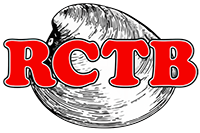Raising Shellfish
Fundamentals of RCTB Growing Oysters
Spat is the industry term for baby oysters. Oysters naturally want to grow in a group on a hard surface called cultch. Oyster larvae will not grow in the muck or sand like clams. Oysters living in a colony on clutch is best for living shoreline projects. There is a technique to grow oysters as individuals for restaurants and research. These are called cultchless oysters. RCTB does grow some cultchless oysters for demonstration purposes.
When growing spat for living shoreline projects, we use a technique called remote set. In a remote set, we provide cultch. This can be old clam or oyster shell (in bags) or oyster castles which are interlocking concrete blocks upon which they grow and create a colony . The remote set technique, introduces eyed larvae (a particular time in their development, just prior to set) to a mixing tank containing the cultch. Within two weeks, the larvae will set on the cultch. A piece of shell will have a colony of from 75 to 100 spat. An oyster castle might contain 500 to 1,000. The advantage is that the large shells or interlocking oyster castles provide a habitat for the oysters and other creatures that reduces predation. RCTB has been experimenting with the remote set technique. The goal is to improve the percentage of spat that set on the shell or oyster castles. Visit Upwellers to see the activity and talk to our volunteers.
Fundamentals of Growing Clam Seed
RCTB purchases about 500,000 seed clams from hatcheries local each year. Baby clams, called seed, are grown in upwellers at various locations around the estuary. After the first season, these clams are taken to several different locations including Island Beach State Park, the Marine Conservation Zone (MCZ) managed by the DEP Bureau of Shellfisheries and undisclosed locations selected by RCTB. Some are left at the Beach Haven Aquaculture Center to overwinter in our floating upweller system (FLUPSY). Visit Upwellers to see the activity and talk to our volunteers.
The process is explained in the Introduction Video
Frequently Asked Questions
How do shellfish reproduce and what is their life cycle?
Shellfish reproduce through a process known as spawning, where males release sperm and females release eggs into the water. Fertilization occurs externally, and the fertilized eggs develop into larvae. The larvae are then carried by water currents until they settle onto a suitable substrate, where they undergo metamorphosis into juvenile shellfish.
What are the different roles that shellfish play in the environment?
Shellfish play several crucial roles in the environment, including:
-
- Water Filtration: Shellfish are filter feeders, meaning they filter and consume plankton and other particles from the water. This helps improve water clarity and quality by removing excess nutrients and contaminants.
- Habitat Creation: Shellfish beds provide important habitat for a variety of marine organisms, including fish, crabs, and other invertebrates. These habitats support biodiversity and contribute to the overall health of marine ecosystems.
- Shoreline Stabilization: The presence of shellfish beds can help stabilize shorelines by reducing erosion. The shells and structure of the beds provide natural barriers that help protect coastal areas from wave action and storm surges.
- Nutrient Cycling: Shellfish play a role in nutrient cycling within ecosystems. They consume organic matter and release nutrients back into the water through their waste, which can be taken up by other organisms and contribute to ecosystem productivity.
- Food Web Support: Shellfish are an important food source for many marine predators, including fish, birds, and mammals. They help support complex food webs and provide a link between primary producers and higher trophic levels.
- Economic Impact: The sale and consumption of clams and oysters is growing and the value of the harvest increases each year. Since 2017 the number of oyster frames has grown from one to seventeen!
What are the key factors to consider when raising shellfish?
When raising shellfish, it’s crucial to pay attention to water quality, temperature, and salinity levels. Proper feeding, regular monitoring, and predator control are also essential.
How do you ensure that shellfish have enough food?
Shellfish primarily feed on phytoplankton and other microscopic organisms present in the water. Ensuring a healthy and diverse aquatic ecosystem can help provide an adequate food supply for shellfish.
How often should the water quality of shellfish beds be checked?
Regular monitoring of water quality parameters such as dissolved oxygen, pH, and nutrient levels is important. It’s recommended to check these parameters weekly or as advised by local regulations.
What types of predators do shellfish face, and how can they be controlled?
Shellfish are vulnerable to predators such as crabs, fish, sea stars, moon snakes, oyster drills, cow nose rays and birds. Installing predator deterrents such as nets or cages can help protect shellfish from predation.
Can shellfish be raised in areas with varying water temperatures?
Shellfish can adapt to a range of water temperatures, but consistent monitoring is necessary. Extreme temperature fluctuations can stress shellfish and affect their growth and survival.
What is the best way to harvest shellfish without damaging the environment?
Harvesting shellfish using sustainable practices such as handpicking or using low-impact harvesting methods can minimize environmental impact. Following local regulations and guidelines is crucial.
